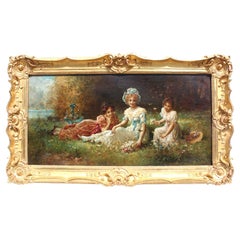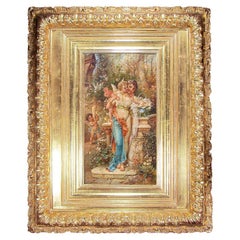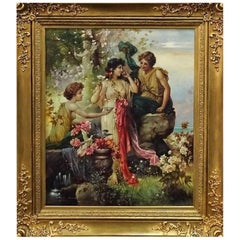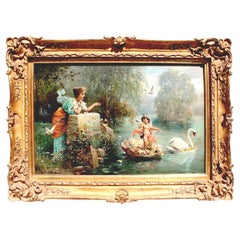Hans Zatzka On Sale
Antique Late 19th Century Austrian Belle Époque Paintings
Canvas, Giltwood
Antique 1880s Austrian Belle Époque Paintings
Wood, Giltwood
Recent Sales
Antique 19th Century Austrian Paintings
Canvas
Antique Late 19th Century Austrian Neoclassical Revival Paintings
Gesso, Wood, Giltwood
Antique Late 19th Century Austrian Beaux Arts Paintings
Gesso, Canvas, Wood, Giltwood
People Also Browsed
Antique Late 19th Century French Empire Revival Console Tables
Marble
Antique Late 19th Century French Louis XVI Grandfather Clocks and Longca...
Malachite, Ormolu
Antique 19th Century French Napoleon III Stairs
Walnut
Antique 19th Century French Louis XVI Beds and Bed Frames
Bronze
2010s British Louis XV Sofas
Hardwood
Antique 19th Century French Rococo Revival Paintings
Canvas, Giltwood
Antique 19th Century French Rococo Busts
Carrara Marble, Siena Marble
Antique 19th Century German Rococo Wall Mirrors
Porcelain, Mirror
Antique 19th Century Unknown Empire Cabinets
Mahogany
Antique 19th Century French Rococo Paintings
Canvas
Antique Early 1900s French Belle Époque Chandeliers and Pendants
Bronze
Antique 18th Century German Rococo Decorative Boxes
Porcelain
Antique 1880s Italian Louis XVI Paintings
Canvas, Wood
Antique Early 1900s French Neoclassical Revival Grandfather Clocks and L...
Onyx, Marble, Bronze
Antique Late 19th Century French Louis XVI Beds and Bed Frames
Ormolu
Antique Mid-19th Century French Louis XIV Fireplaces and Mantels
Breccia Marble, Bronze
Finding the Right Paintings for You
When paired with the perfect frame, the right antique and vintage paintings and other wall decorations can either subtly showcase your personality or steal the show altogether.
The earliest paintings were created on the walls of caves, proving even our ancient ancestors knew that striking artwork is meant to be on display. Cave paintings on an Indonesian island are reportedly older than the earliest cave art in Spain and France, and the figurative paintings back then were produced with inorganic pigments like iron oxide.
Later, the people of Ancient Greece — who learned about art from the Egyptians before them — conceived panel paintings of wax and tempera that were collected and publicly displayed. In the centuries that followed, artists would be commissioned to create large-scale wall murals and frescoed ceilings in sprawling European palaces and in the homes of the aristocracy.
Today, 1stDibs makes it easy for you to celebrate this rich history in your own home. Our collection of paintings includes Art Deco paintings, baroque art and a broad range of other categories. Search by material, period or other attributes to find the right fit — browse an array of 19th century landscape paintings in giltwood frames or abstract oil paintings and portraits made during the 1950s and ‘60s.
An understated contemporary work can complement your space’s color palette without drawing the focus away from the other pivotal design choices you’ve made over the years. Roy Lichtenstein’s Pop art, on the other hand, demands attention with its array of vibrant hues and subjects inspired by popular culture.
Whether you aim to create a gallery in your home or build a single, stunning focal point, you can find what you’re looking for in an extensive inventory of paintings on 1stDibs.
- 1stDibs ExpertMarch 22, 2022Most Hans Zatzka paintings are in the private collections of art collectors around the world. You can also find pieces produced by the Austrian fantasy artist for sale from dealers and on reputable online platforms. Shop a range of Hans Zatzka paintings on 1stDibs.
- What style is Hans Zatzka?1 Answer1stDibs ExpertApril 5, 2022The Austrian painter Hans Zatzka’s work is classified as classical academic realism. His work often focused on religious and mythological themes with an air of fantasy. Many of his works were dedicated to various churches, but he also painted under many pseudonyms to break from his contracted work and focused on paintings of women, fairies and fantasy-based scenes. Shop a selection of Zatzka pieces from some of the world’s top art dealers on 1stDibs.
Read More
Whether Painted or Papered, Muraled Walls Make Bold Statements in the Home
The ancient practice of covering walls in artistic scenery is back.
In Francks Deceus’s ‘Mumbo Jumbo #5,’ the Black Experience Is . . . Complicated
Despite the obstacles, the piece’s protagonist navigates the chaos without losing his humanity.
12 Floral-Accented Rooms with a Handmade, Folkloric Feel
Who needs a flower garden? Just use your imagination — and some beautifully patterned wallpaper or fabric — to bring the outdoors in.
This Wolf Kahn Pastel Is the Epitome of Beauty at Its Most Essential
A longtime admirer of Kahn’s work, 1stDibs editorial director Anthony Barzilay Freund explores why it’s relevant now more than ever.
Why Jules Chéret Was the King of the Modern Poster
The streets of fin-de-siècle Paris were set aglow with colorful poster ads, thanks to the printing techniques invented by Jules Chéret. Now, the Milwaukee Art Museum is celebrating this undersung talent in America's first solo show dedicated his exuberant works.
Anna Condo’s Multifaceted Career Spans Film, Photography and NFTs
From her historic Manhattan townhouse, the talented creator and curator of 1stDibs' latest NFT exhibition tells us about the art in her home and how she got involved with cryptoart.
How Keith Rivers Went from NFL Linebacker to Blue-Chip Art Aficionado
The former football player is as serious about becoming a great contemporary-art patron as he once was about making tackles. Here, Rivers tells us how he got the collecting bug and how his tastes have evolved over the years.
More Than Ever, the Female Design Council Is Embracing Funked-Up Creativity
The organization's "Womxn’s History Month" collection celebrates female-identified creators pushing the boundaries of technique and material.



